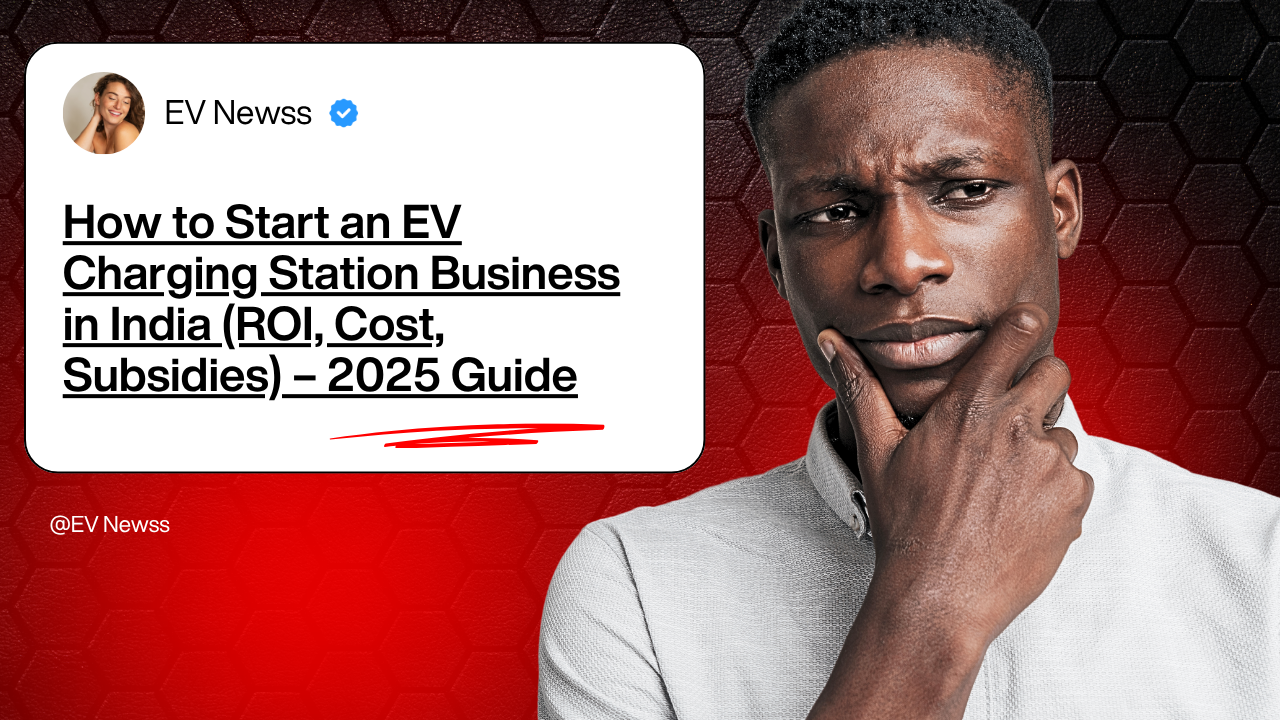The electric vehicle (EV) revolution in India is no longer a prediction—it’s a reality. With increasing adoption rates, the Indian government’s aggressive push for electrification, and a growing consumer base concerned about sustainability and rising fuel prices, the EV market is thriving. However, one critical aspect that will determine the success of EV penetration is charging infrastructure. In 2025, establishing an EV charging station business presents an exciting, relatively low-competition opportunity with significant financial upside.
This comprehensive guide explores everything you need to know about starting your own EV charging station in India in 2025—from investment and location planning to subsidies and return on investment (ROI).
Why 2025 Is the Ideal Time ?
India is on the cusp of mass electric mobility adoption. Consider the following:
- EV Sales Growth: Over 1.5 million electric vehicles were sold in 2024—a number expected to exceed 3 million by 2026.
- Government Push: The FAME-II scheme (Faster Adoption and Manufacturing of Hybrid and Electric Vehicles) offers significant incentives for infrastructure development.
- Urban Policy Support: The Power Ministry mandates charging stations every 3 km in cities and every 25 km on highways.
- Startup-Friendly Environment: Several state governments are offering land, tax breaks, and capital support for clean energy initiatives.
These signals make 2025 a prime time to enter the EV charging market.
Step-by-Step Process to Set Up an EV Charging Station in India
Step 1: Identify a High-Traffic Location
Location is everything. You need an accessible area with heavy footfall and proximity to existing or upcoming EV hubs.
Ideal locations include:
- Shopping malls
- Corporate IT parks
- Petrol pumps
- Highway rest stops
- Apartment complexes
- Metro stations or railway parking lots
Tip: Lease or rent space near transport corridors for maximum visibility and usage.
Step 2: Choose the Type of Charger to Install
| Charger Type | Charging Time | Target Vehicles | Approx. Cost (INR) |
|---|---|---|---|
| AC Type 2 | 6–8 hours | 2W/3W/4W (private use) | ₹1–2 lakh |
| DC Fast | 30–90 minutes | Commercial cars | ₹10–15 lakh |
| CCS Combo | 45–90 minutes | SUVs, sedans | ₹7–10 lakh |
| CHAdeMO | 30–60 minutes | Japanese EVs | ₹10–12 lakh |
Recommendation: Start with a mix of Type 2 AC and one DC fast charger to balance investment and revenue.
Step 3: Calculate Your Investment & ROI
- Initial Setup Cost: ₹10–40 lakh depending on charger type, land cost, infrastructure setup, and number of ports.
- Operating Costs:
- Electricity charges
- Maintenance
- Software/app integration
- Staff salaries (if any)
Revenue Streams
- Per Unit Charging: Charge ₹15–₹18 per kWh (unit).
- Subscription Models: Offer monthly plans to delivery fleets or cab companies.
- Ancillary Revenue: Allow display ads or sell beverages/snacks at the charging point.
ROI Expectation: With moderate usage (15–20 vehicles/day), you can break even in 2–3 years.
Step 4: Licensing, Permissions & Legal Requirements
- No license required: As per the Ministry of Power’s 2018 notification.
- Approvals Needed:
- Local municipal NOC
- Fire and safety clearance
- Electrical connection and load approval from DISCOM
- Pollution Control Board clearance (in some cases)
Required Equipment:
- EVSE (Electric Vehicle Supply Equipment)
- Transformer (for high-capacity stations)
- Energy meter and billing system
- Smart app for monitoring and payment
Step 5: Apply for Government Subsidies & Incentives
Here’s how the government supports new EV charging businesses:
| Scheme | Benefit | How to Apply |
| FAME-II | Capital subsidy for chargers (up to 25%) | Apply through Department of Heavy Industries (DHI) portal |
| State Subsidies | Some states offer ₹1–₹5 lakh station setup grants | Check with local state EV policy |
| Tax Benefits | Accelerated depreciation under Sec 35AD | Through your CA or auditor |
Many banks now also offer green loans at reduced interest rates.
Mistakes to Avoid
- Selecting poor locations with minimal vehicle traffic
- No integration with mobile apps for payments or real-time availability
- Ignoring maintenance, leading to longer downtimes and poor customer experience
- Underestimating utility charges and transformer upgrades
List of Popular Charging Equipment Providers in India
| Company | Website | Highlights |
| Exicom | exicom.in | Trusted DC fast charger maker |
| Delta India | deltaelectronicsindia.com | End-to-end charging solutions |
| ABB India | abb.com | Global brand with Indian operations |
| Tvesas Electric | tvesas.com | Budget-friendly Indian manufacturer |
FAQs
Q1. Can I install solar panels to power my EV station?
Yes. Hybrid systems are popular and reduce operational costs significantly over time.
Q2. How long does it take to set up a station?
Usually 3–6 months, including site surveys, installation, and approvals.
Q3. Is it mandatory to provide both AC and DC chargers?
No, but having both increases your customer base and usability.
Q4. How many EVs are needed per day to be profitable?
Around 20–30 vehicles/day depending on your per-unit charge and electricity rate.
Conclusion
The EV sector in India is growing rapidly, and charging infrastructure is a goldmine for early movers. With low competition, government support, and a rising number of electric vehicles, launching an EV charging station in 2025 can become a high-ROI business within just a few years. Plan wisely, choose the right location and equipment, and integrate digital tools to ensure long-term profitability.

1 thought on “How to Start an EV Charging Station Business in India (ROI, Cost, Subsidies) – 2025 Guide”